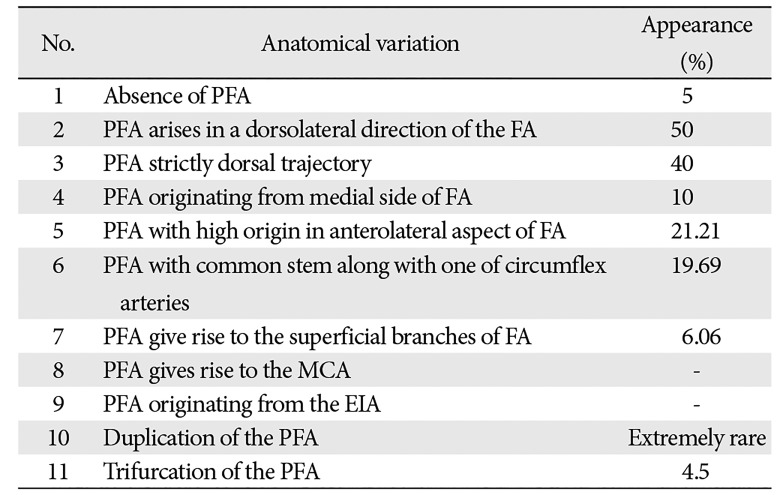1. Drake RL, Vogl AW, Mitchell AW. Gray's basic anatomy. Philadelphia, PA: Elsevier Health Sciences;2016.
2. Netter F. Atlas of human anatomy. 6th ed. Philadelphia, PA: Elsevier;2014.
3. Manjappa T, Prasanna LC. Anatomical variations of the profunda femoris artery and its branches-a cadaveric study in South Indian population. Indian J Surg. 2014; 76:288–292. PMID:
25278652.
4. Rajani SJ, Ravat MK, Rajani JK, Bhedi AN. Cadaveric study of profunda femoris artery with some unique variations. J Clin Diagn Res. 2015; 9:AC01–AC03.
5. Choy KW, Kogilavani S, Norshalizah M, Rani S, Aspalilah A, Hamzi H, Farihah HS, Das S. Topographical anatomy of the profunda femoris artery and the femoral nerve: normal and abnormal relationships. Clin Ter. 2013; 164:17–19. PMID:
23455736.
6. Heberer G, van Dongen RJ. Vascular surgery. Berlin: Springer-Verlag;2012.
7. Tubbs RS, Shoja MM, Loukas M. Bergman's comprehensive encyclopedia of human anatomic variation. Hoboken: John Wiley & Sons;2016.
8. Sahin B, Bilgiç S. Two rare arterial variations of the deep femoral artery in the newborn. Surg Radiol Anat. 1998; 20:233–235. PMID:
9706685.
9. Standring S. Gray's anatomy: the anatomical basis of clinical practice. London: Elsevier Health Sciences;2015.
10. Lippert H, Pabst R. Arterial variations in man: classification and frequency. Muenchen: Bergmann;1985.
11. Lausjaunias P, Berenstein A, ter Brugge K. Clinical vascular anatomy and variations. Berlin: Springer Verlag;2013.
12. Fernández-Riera R, Hung SY, Wu JC, Tsao CK. Free profunda femoris artery perforator flap as a first-line choice of reconstruction for partial glossectomy defects. Head Neck. 2017; 39:737–743. PMID:
28032690.
13. Connor D, Sharp M, Rajagopalan S. Profunda femoris artery aneurysm causing local deep venous thrombosis. J Vasc Surg. 2013; 57:1402. PMID:
23601594.
14. Megalopoulos A, Vasiliadis K, Chatzopoulos S, Kotronis A. Profunda femoris as an access site vessel for a hybrid approach to the treatment of a para-anastomotic common iliac artery aneurysm and intermittent claudication, occurring after previous abdominal aortic thbe graft repair and femoro-femoral bypass graft. A case report. Acta Chir Belg. 2009; 109:791–796. PMID:
20184072.
15. Tsoucalas G. Anatomy: an essential course for future surgeons. J Univers Surg. 2018; 6:8.

